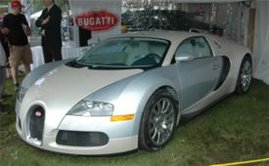According to Volkswagen, the final production Veyron engine produces between 1020 and 1040 metric hp (1006 to 1026 SAE net hp), so the car will be advertised as producing "1001 horsepower" in both the US and European markets. This makes it the most powerful production road-car engine in history. Peak torque is 1250 N·m (922 ft·lbf).
Top speed was initially promised to be 406 km/h (252 mph), but test versions were unstable at that speed, forcing a redesign of the aerodynamics. In May 2005, a prototype Veyron tested at a Volkswagen track near Wolfsburg, Germany, and recorded an electronically limited top speed of 400 km/h (249 mph). In October, 2005, Car and Driver magazine's editor Csaba Csere test drove the final production version of the Veyron for the November 2005 issue. This test, at Volkswagen's Ehra-Lessien test track, reached a top speed of 407.5 km/h (253.2 mph). The top speed was verified once again by James May on Top Gear, again at Volkswagen's private test track. When getting close to the top speed during the test he said that "the tires will only last for about fifteen minutes, but it's okay because the fuel runs out in twelve." He also gave an indication of the power requirements, at 249 km/h (155 mph) the Veyron was using approximately 270 BHP (201 kW), but to get to its rated 407 km/h (253 mph) top speed required far more from the engine. The power required to overcome aerodynamic drag is proportional to the cube of the speed. Therefore, to go twice the speed, you need eight times the power.
The Veyron is the quickest production car to reach 100 km/h (62 mph) with an estimated time of 2.5 seconds, according to the manufacturer. It reaches 60 mph in approximately 2.46 seconds. It also reaches 200 and 300 km/h (124 and 186 mph) in 7.3 and 16.7 seconds respectively. This makes the Veyron the quickest accelerating production car in history. It also consumes more fuel than any other production car, using 40.4 L/100 km (5.82 mpg) in city driving and 24.1 L/100 km (10 mpg) in combined cycle. At full throttle, it uses more than 125 L/100 km (2.1 mpg), which would empty its 100 L (26.4 gallon) fuel tank in just 12.5 minutes. The car's everyday top speed is listed at 377 km/h (234 mph). When the car reaches 220 km/h (137 mph), hydraulics lower the car until it has a ground clearance of about 8.9 cm (3½ inches). At the same time, the wing and spoiler deploy. This is the "handling" mode, in which the wing helps provide 770 pounds (3425 newtons) of downforce, holding the car to the road. The driver must, using a special key (the "Top Speed Key"), toggle the lock to the left of his seat in order to use the maximum speed of 407.5 km/h (253.2 mph). The key functions only when the vehicle is at a stop when a checklist then establishes whether the car - and its driver - are ready to enable 'top speed' mode. If all systems are go, the rear spoiler retracts, the front air diffusers close and the ground clearance, normally 12.4 cm (4.9 inches), drops to 6.6 cm (2.6 inches).
The Veyron's brakes utilize unique cross-drilled and turbine-vented carbon rotors, which draw in cooling air to reduce fade. Each caliper has eight titanium pistons. Bugatti claims maximum deceleration of 1.3 g on road tires. Prototypes have been subjected to repeated 1.0 g braking from 194 to 50 mph (312 to 80 km/h) without fade. With the car's fearsome acceleration from 50 to 194 mph (80 to 312 km/h), that test can be performed every 22 seconds. At speeds above 124 mph (200 km/h), the rear wing also acts as an airbrake, snapping to a 70-degree angle in 0.4 seconds once brakes are applied, providing 0.5 g (4.9 m/s²) of deceleration. Bugatti claims the Veyron will brake from 252 mph (406 km/h) to a standstill in less than 10 seconds. The braking is also so evenly applied that the car will not deviate from a straight path if the driver lets go of the steering wheel, even with the brakes fully applied starting from close to top speed.
Subscribe to:
Post Comments (Atom)

No comments:
Post a Comment